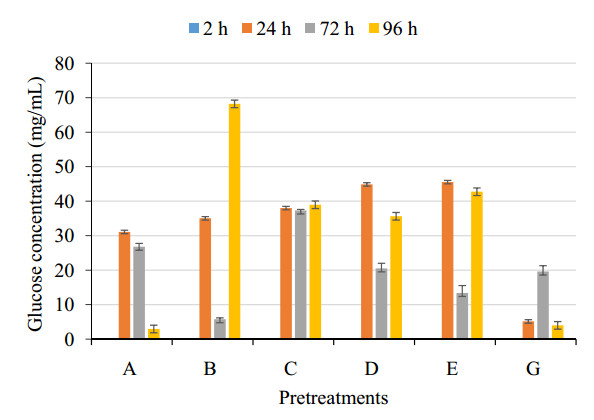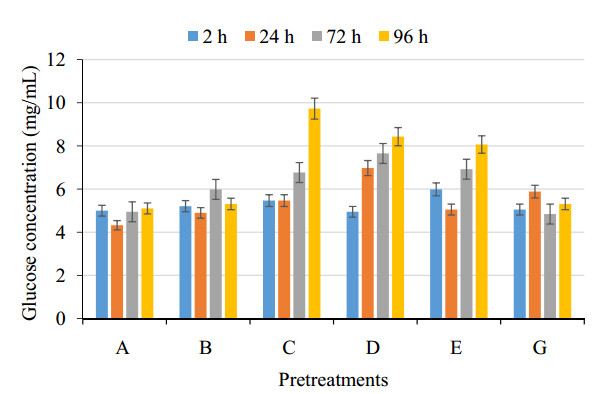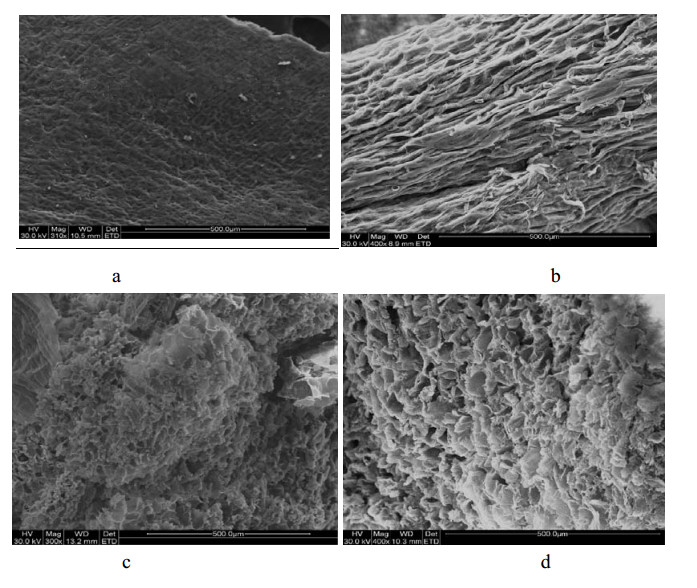Production of high value-added products from lignocelluloses is an economically sustainable alternative to decreasing dependence on fossil fuels and making the chemical processes environmentally friendly. In this study, different methodologies of alkaline (Ca(OH)2 and NaOH), dilute acid (10%w/w H2SO4), hydrogen peroxide (H2O2), alkaline peroxide oxidation (H2O2/Ca(OH)2 and H2O2/NaOH), and molten hydrated salt (MHS) mediated (ZnCl2.4H2O) pretreatments were employed in the hydrolysis of corncob amenable to enzymatic hydrolysis. Optimal enzyme hydrolysis temperature (considering 45 and 50 ℃) and time (2, 24, 72, and 96 h) were investigated for each pretreatment procedure to ascertain the concentrations of glucose, xylose, and total sugar present in the corncob. At 45 ℃ and 96 h, NaOH alkaline pretreatment achieved the best optimum total sugar production of 75.54 mg/mL (about 54% and 88% increments compared to dilute acid pretreatment (35.06 mg/mL total sugars) and MHS (9.32 mg/mL total sugar) pretreatment respectively). In this study, total sugars production increased appreciably at 45 ℃ and longer hydrolysis period (96 h) compared to hydrolysis at 50 ℃ (with maximum total sugars production of 18.00 mg/mL at 96 h). Scanning electron microscopic imaging of the untreated and treated samples displayed cell wall distortion and surface disruptions.
1.
Motivations and outline
In [12,Definition 11.2] and [18,p. 134,Theorem A], the second kind Bell polynomials Bn,k for n≥k≥0 are defined by
where N0={0}∪N, the sum is taken over ℓ=(ℓ1,ℓ2,…,ℓn−k+1) with ℓi∈N0 satisfying ∑n−k+1i=1ℓi=k and ∑n−k+1i=1iℓi=n. This kind of polynomials are very important in combinatorics, analysis, and the like. See the review and survey article [53] and closely related references therein.
In [36,pp. 13–15], when studying Grothendieck's inequality and completely correlation-preserving functions, Oertel obtained the interesting identity
for n∈N, where
In [36,p. 15], Oertel wrote that "However, already in this case we don't know a closed form expression for the numbers
An even stronger problem appears in the complex case, since already a closed-form formula for the coefficients of the Taylor series of the inverse of the Haagerup function is still unknown''.
By virtue of the relation (1.1), we see that, to find a closed-form formula for the sequence (1.2), it suffices to discover a closed-form formula for
In this paper, one of our aims is to derive closed-form formulas for the sequence (1.3). The first main result can be stated as the following theorem.
Theorem 1.1. For k,n≥0, m∈N, and xm∈C, we have
For k,n∈N, we have
and
where s(n,k), which can be generated by
denote the first kind Stirling numbers and
In Section 2, for proving Theorem 1.1, we will establish two general expressions for power series expansions of (arcsinx)2ℓ−1 and (arcsinx)2ℓ respectively.
In Section 3, with the aid of general expressions for power series expansions of the functions (arcsinx)2ℓ−1 and (arcsinx)2ℓ established in Section 2, we will prove Theorem 1.1 in details.
In Section 4, basing on arguments in [20,p. 308] and [28,Section 2.4] and utilizing general expressions for power series expansions of (arcsinx)2ℓ−1 and (arcsinx)2ℓ established in Section 2, we will derive series representations of generalized logsine functions which were originally introduced in [34] and have been investigating actively, deeply, and systematically by mathematicians [9,10,14,15,16,17,29,30,31,37,38,57] and physicists [3,19,20,28].
Finally, in Section 5, we will list several remarks on our main results and related stuffs.
2.
Power series expansions for the powers of the arcsine function
To prove Theorem 1.1, we need to establish the following general expressions of the power series expansions of (arcsinx)ℓ for ℓ∈N.
Theorem 2.1. For ℓ∈N and |x|<1, the functions (arcsinx)ℓ can be expanded into power series
or
where s(n,k) denotes the first kind Stirling numbers generated in (1.5) and T(r;q,j;ρ) is defined by (1.6).
Proof. In [4,pp. 262–263,Proposition 15], [7,p. 3], [20,p. 308], and [28,pp. 49–50], it was stated that the generating expression for the series expansion of (arcsinx)n with n∈N is
where b0(t)=1, b1(t)=t, and
for ℓ∈N. This means that, when writing
where β0,0=1, β2ℓ,0=0, β2ℓ,2k+1=0, and β2ℓ−1,2k=0 for k≥0 and ℓ≥1, we have
Equating coefficients of tℓ gives
It is not difficult to see that
where i=√−1 is the imaginary unit and
is called the rising factorial of z∈C, while
is called the falling factorial of z∈C. Making use of the relation
in [52,p. 167], we acquire
Utilizing the relation (1.5) in [59,p. 19,(1.26)], we obtain
and
This means that
and
Further equating coefficients of tk+2 and tk+1 respectively arrives at
for k≥0.
Replacing ℓ by 2ℓ−1 for ℓ∈N in (2.3) leads to
Replacing ℓ by 2ℓ for ℓ∈N in (2.3) leads to
The proof of Theorem 2.1 is complete.
3.
Proof of Theorem 1.1
We now start out to prove Theorem 1.1.
In the last line of [18,p. 133], there exists the formula
for k≥0. When taking x2m−1=0 for m∈N, the left hand side of the formula (3.1) is even in t∈(−∞,∞) for all k≥0. Therefore, the formula (1.4) is valid.
Ones know that the power series expansion
is valid, where (−1)!!=1. This implies that
Employing the formula
in [18,p. 136], we derive
Making use of the formula (3.1) yields
Setting x_1 = 0 and x_m = (\arcsin t)^{(m)}|_{t = 0} for m\ge2 gives
Accordingly, we obtain
and
From the power series expansions (2.1) and (2.2) in Theorem 2.1, it follows that
and
Therefore, we arrive at
and
Consequently, we acquire
and
The proof of Theorem 1.1 is complete.
4.
Series representation of generalized logsine functions
The logsine function
and generalized logsine function
were introduced originally in [34,pp. 191–192], where \ell, j are integers, j\ge\ell+1\ge1 , and \theta is an arbitrary real number. There have been many papers such as [3,9,10,14,15,16,17,19,20,28,29,30,31,37,38,57] devoted to investigation and applications of the (generalized) logsine functions in mathematics, physics, engineering, and other mathematical sciences.
Theorem 4.1. Let \langle z\rangle_n for z\in\mathbb{C} and n\in\{0\}\cup\mathbb{N} denote the falling factorial defined by (2.4) and let T(r; q, j;\rho) be defined by (1.6). In the region 0 < \theta\le\pi and for j, \ell\in\mathbb{N} , generalized logsine functions {\rm{Ls}}_j^{(\ell)}(\theta) have the following series representations:
1. for j\ge2\ell+1\ge3 ,
2. for j\ge2\ell+2\ge4 ,
3. for j\ge2\ell-1\ge1 ,
4. for j\ge2\ell-1\ge1 ,
Proof. In [28,p. 49,Section 2.4], it was obtained that
for 0 < \theta\le\pi and j-k-2\ge0 . Making use of Theorem 2.1 and the formula
in [22,p. 238,2.722], we acquire
for j\ge2\ell+1\ge3 . Substituting this result into (4.5) for k = 2\ell-1 yields (4.1).
Similarly, by virtue of Theorem 2.1 and the formula (4.6), we also have
for \ell\in\mathbb{N} and j\ge2(\ell+1)\ge4 . Substituting this result into (4.5) for k = 2\ell yields (4.2).
In [20,p. 308], it was derived that
for 0 < \theta\le\pi and j\ge k+1\ge1 . Differentiating with respect to x on both sides of the formulas (2.1) and (2.2) in Theorem 2.1 results in
and
for \ell\in\mathbb{N} . Substituting the power series expansions (4.8) and (4.9) into (4.7) and employing the indefinite integral (4.6) respectively reveal
for j\ge2\ell-1\ge1 and
for j\ge2\ell\ge1 . The series representations (4.3) and (4.4) are thus proved. The proof of Theorem 4.1 is complete.
5.
Remarks
Finally, we list several remarks on our main results and related stuffs.
Remark 5.1. For n\ge k\ge1 , the first kind Stirling numbers s(n, k) can be explicitly computed by
The formula (5.1) was derived in [41,Corollary 2.3] and can be reformulated as
for n\ge k\ge1 . From the equation (1.5), by convention, we assume s(n, k) = 0 for n < k and k, n < 0 . In recent years, the first kind Stirling numbers s(n, k) have been investigated in [39,40,41,42,45] and closely related references therein.
Remark 5.2. For |x| < 1 , we have the following series expansions of \arcsin x and its powers.
1. The series expansion (3.2) of \arcsin x can be rewritten as
where (-1)!! = 1 . Various forms of (5.2) can be found in [1,4.4.40] and [2,p. 121,6.41.1].
2. The series expansion of (\arcsin x)^2 can be rearranged as
The variants of (5.3) can be found in [2,p. 122,6.42.1], [4,pp. 262–263,Proposition 15], [5,pp. 50–51 and p. 287], [6,p. 384], [7,p. 2,(2.1)], [13,Lemma 2], [20,p. 308], [21,pp. 88-90], [22,p. 61,1.645], [32,p. 1011], [33,p. 453], [47,Section 6.3], [58], [60,p. 59,(2.56)], or [62,p. 676,(2.2)]. It is clear that the series expansion (5.3) and its equivalent forms have been rediscovered repeatedly. For more information on the history, dated back to 1899 or earlier, of the series expansion (5.3) and its equivalent forms, see [7,p. 2] and [32,p. 1011].
3. The series expansion of (\arcsin x)^3 can be reformulated as
Different variants of (5.4) can be found in [2,p. 122,6.42.2], [4,pp. 262–263,Proposition 15], [11,p. 188,Example 1], [20,p. 308], [21,pp. 88–90], [22,p. 61,1.645], or [27,pp. 154–155,(832)].
4. The series expansion of (\arcsin x)^4 can be restated as
There exist three variants of (5.5) in [4,pp. 262–263,Proposition 15], [7,p. 3,(2.2)], and [20,p. 309].
5. Basing on the formula (2.21) in [28,p. 50], we concretely obtain
6. In [7], the special series expansions
were listed. In general, it was obtained in [7,pp. 1–2] that
and
where H_1(n) = \frac{1}{4} , G_0(n) = 1 ,
and
The convention is that the sum is zero if the starting index exceeds the finishing index.
7. In [7,(2.9) and (4.3)], [25,p. 480,(88.2.2)], and [56,p. 124], there exist the formulas
and
All the power series expansions from (5.2) to (5.6) can also be deduced from Theorem 2.1.
By the way, we notice that the quantity in the pair of bigger brackets, the coefficient of x^{2n} , in the formula (5.9) has no explicit relation with n . This means that there must be some misprints and typos somewhere in the formula (5.9). On 30 January 2021, Christophe Vignat (Tulane University) pointed out that n_0 = n is the missing information in the formula (5.9).
In [28,pp. 49–50,Section 2.4], the power series expansions of (\arcsin x)^k for 2\le k\le 13 were concretely and explicitly written down in alternative forms. The main idea in the study of the power series expansions of (\arcsin x)^k for 2\le k\le 13 was related with series representations for generalized logsine functions in [28,p. 50,(2.24) and (2.25)]. The special interest is special values of generalized logsine functions defined by [28,p. 50,(2.26) and (2.27)].
In [54,Theorem 1.4] and [55,Theorem 2.1], the n th derivative of \arcsin x was explicitly computed.
In [43,44], three series expansions (5.2), (5.3), (5.4) and their first derivatives were used to derive known and new combinatorial identities and others.
Because coefficients of x^{2n+2\ell-1} and x^{2n+2\ell} in (2.1) and (2.2) contain three times sums, coefficients of x^{2n} and x^{2n+1} in (5.7) and (5.8) contain \ell times sums, coefficients of x^{2n} in (5.9) contain \ell-1 times sums, and coefficients of x^n in (5.10) contain \ell times sums, we conclude that the series expansions (2.1) and (2.2) are more elegant, more operable, more computable, and more applicable.
Remark 5.3. Two expressions (2.1) and (2.2) in Theorem 2.1 for series expansions of (\arcsin x)^{2\ell-1} and (\arcsin x)^{2\ell} are very close and similar to, but different from, each other. Is there a unified expression for series expansions of (\arcsin x)^{2\ell-1} and (\arcsin x)^{2\ell} ? If yes, two closed-form formulas for {\rm{B}}_{2n, k} in Theorem 1.1 would also be unified. We believe that the formula
mentioned in [7,p. 3,(2.7)] and collected in [25,p. 210,(10.49.33)] would be useful for unifying two expressions (2.1) and (2.2) in Theorem 2.1, where extended Pochhammer symbols
were defined in [25,p. 5,Section 2.2.3], and the Euler gamma function \Gamma(z) is defined [59,Chapter 3] by
What are closed forms and why do we care closed forms? Please read the paper [8].
Remark 5.4. In [2,p. 122,6.42], [27,pp. 154–155,(834)], [33,p. 452,Theorem], and [47,Section 6.3,Theorem 21,Sections 8 and 9], it was proved or collected that
In [6,p. 385], [47,Theorem 24], and [61,p. 174,(10)], it was proved that
These series expansions (5.13) and (5.14) can be derived directly from the series expansion for (\arcsin x)^2 and are a special case of (4.9) for \ell = 1 .
Remark 5.5. The series expansion of the function \sqrt{1-x^2}\, \arcsin x was listed in [2,p. 122,6.42.4] which can be corrected and reformulated as
Basing on the relation
and utilizing series expansions of (\arcsin x)^3 and (\arcsin x)^4 , after simple operations, we can readily derive
and
From (4.8) and (4.9), we can generalize the series expansions (5.15), (5.16), and (5.17) as
and
for \ell\in\mathbb{N} , where
and T(r; q, j;\rho) is defined by (1.6). Considering both coefficients of x^{2\ell-2} and x^{2\ell-1} in the power series expansions (5.18) and (5.19) must be 1 , we acquire two combinatorial identities
for \ell\in\{0\}\cup\mathbb{N} , where T(r; q, j;\rho) is defined by (1.6).
Remark 5.6. Making use of Theorem 1.1, we readily obtain the first several values of the sequence (1.3) in Tables 1 and 2.
In the papers [46,48,49,50,51,52,53,54,55] and closely related references therein, the authors and their coauthors discovered and applied closed form expressions for many special values of the second kind Bell polynomials {\rm{B}}_{n, k}(x_1, x_2, \dotsc, x_{n-k+1}) for n\ge k\ge0 .
Remark 5.7. Taking \theta = \frac{\pi}{3} in (4.3) and (4.4) give
and
for \ell\in\mathbb{N} , where \langle z\rangle_n for z\in\mathbb{C} and n\in\{0\}\cup\mathbb{N} denotes the falling factorial defined by (2.4) and T(r; q, j;\rho) is defined by (1.6). In [28,p. 50], it was stated that the values {\rm{Ls}}_j^{(\ell)}\bigl(\frac{\pi}{3}\bigr) have been related to special interest in the calculation of the multiloop Feynman diagrams [19,20].
Similarly, we can also deduce series representations for special values of the logsine function {\rm{Ls}}_j^{(\ell)}(\theta) at \theta = \frac{\pi}{2} , \frac{\pi}{4} , \frac{\pi}{6} and \theta = \pi . These special values were originally derived in [30,31,34] and also considered in [3,9,10,14,15,16,17,19,20,28,29,37,38,57] and closely related references therein.
Remark 5.8. This paper is a revised version of electronic arXiv preprints [23,24].
6.
Acknowledgements and declarations
6.1. Acknowledgements
The authors thank
1. Frank Oertel (Philosophy, Logic & Scientific Method Centre for Philosophy of Natural and Social Sciences, London School of Economics and Political Science, UK; f.oertel@email.de) for his citing the paper [53] in his electronic preprint [35]. On 10 October 2020, this citation and the Google Scholar Alerts leaded the authors to notice the numbers (1.2) in [35]. On 26 January 2021, he sent the important paper [7] to the authors and others. We communicated and discussed with each other many times.
2. Chao-Ping Chen (Henan Polytechnic University, China; chenchaoping@sohu.com) for his asking the combinatorial identity in [43,Theorem 2.2], or the one in [44,Theorem 2.1], via Tencent QQ on 18 December 2020. Since then, we communicated and discussed with each other many times.
3. Mikhail Yu. Kalmykov (Bogoliubov Laboratory of Theoretical Physics, Joint Institute for Nuclear Research, Russia; kalmykov.mikhail@googlemail.com) for his noticing [43,Remark 4.2] and providing the references [19,20,28,30,31,34] on 9 and 27 January 2021. We communicated and discussed with each other many times.
4. Li Yin (Binzhou University, China; yinli7979@163.com) for his frequent communications and helpful discussions with the authors via Tencent QQ online.
5. Christophe Vignat (Department of Physics, Universite d'Orsay, France; Department of Mathematics, Tulane University, USA; cvignat@tulane.edu) for his sending electronic version of those pages containing the formulas (5.9), (5.11), and (5.12) in [25,56] on 30 January 2021 and for his sending electronic version of the monograph [27] on 8 February 2021.
6. Frédéric Ouimet (California Institute of Technology, USA; ouimetfr@caltech.edu) for his photocopying by Caltech Library Services and transferring via ResearchGate those two pages containing the formulas (5.9) and (5.11) on 2 February 2021.
7. anonymous referees for their careful corrections to and valuable comments on the original version of this paper.
6.2. Funding
The author Dongkyu Lim was partially supported by the National Research Foundation of Korea under Grant NRF-2021R1C1C1010902, Republic of Korea.
6.3. Authors' contributions
All authors contributed equally to the manuscript and read and approved the final manuscript.
Conflict of interest
The authors declare that they have no conflict of interest.









 DownLoad:
DownLoad:








